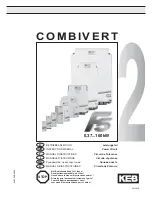
234
SIEPCYEUOQ2V01A Q2V Technical Manual
Code
Name
Causes
Possible Solutions
The braking resistor or braking resistor unit wiring
is incorrect.
Correct wiring errors in the connection to the braking resistor or
braking resistor unit.
Electrical interference caused a drive malfunction.
•
Examine the control circuit lines, main circuit lines, and
ground wiring, and decrease the effects of electrical
interference.
•
Make sure that a magnetic contactor is not the source of the
electrical interference, then use a Surge Protective Device if
necessary.
The load inertia is set incorrectly.
•
Examine the load inertia settings with KEB, overvoltage
suppression, or stall prevention during deceleration.
•
Adjust
L3-25 [Load Inertia Ratio]
to match the qualities of the
machine.
The Short Circuit Braking function used in OLV/
PM control method.
Connect a braking resistor to the drive.
There is motor hunting.
•
Set
n1-01 = 1 [HuntPrev Selection = Enabled]
and adjust
n1-
02 [HuntPrev Gain Setting]
.
•
Adjust
n2-02 [AFR Time 1]
and
n2-03 [AFR Time 2]
.
•
Adjust
n8-45 [SpdFbck Det.Gain]
and
n8-47 [Pull-In Comp.
Time Constant]
.
Speed search does not complete at start when you
set
A1-02 = 8 [EZ Vector]
and use an induction
motor.
When
E9-01 = 0 [Motor Type Selection = IM]
, set
b3-24 = 2
[SpSrch Method Selection = Current Det2]
.
Note:
•
The drive detects this error if the DC bus voltage is more than the
ov
detection level while the drive is running.
•
The
ov
detection level is approximately 410 V with 200 V class drives. The detection level is approximately 820 V for 400 V class drives.
•
Do a Fault Reset to clear the fault.
•
L5-08 [U/OV,OH,GF A-Reset Select]
disables the Auto Restart function.
Code
Name
Causes
Possible Solutions
PE1, PE2
PLC Faults
The communication option detected a fault.
Refer to the manual for the communication option card.
Note:
Do a Fault Reset to clear the fault.
Code
Name
Causes
Possible Solutions
PF
Input Phase Loss
There is a phase loss in the drive input power.
Correct errors with the wiring for main circuit drive input power.
There is loose wiring in the drive input power
terminals.
Tighten the terminal screws to the correct tightening torque.
The drive input power voltage is changing too
much.
•
Examine the input power for problems.
•
Make the drive input power stable.
•
If the input power supply is good, examine the magnetic
contactor on the main circuit side for problems.
There is unsatisfactory balance between voltage
phases.
•
Examine the input power for problems.
•
Make the drive input power stable.
•
Set
L8-05 = 0 [In PhaseLoss Selection = Disabled]
.
The main circuit capacitors have become
unserviceable.
•
Examine the capacitor maintenance time in monitor
U4-05
[Capacitor Maintenance]
. If
U4-05
is more than 90%, replace
the control board or the drive. For information about replacing
the control board, contact the manufacturer or your nearest
sales representative.
•
If drive input power is correct and the fault stays, replace the
control board or the drive. For information about replacing the
control board, contact the manufacturer or your nearest sales
representative.
Note:
•
The drive detects this error if the DC bus voltage changes irregularly without regeneration.
•
Do a Fault Reset to clear the fault.
•
Use
L8-05
to enable and disable
PF
detection.
Code
Name
Causes
Possible Solutions
PGo
Encoder (PG) Feedback Loss
The holding brake is stopping the motor.
Release the holding brake.
Note:
•
Do a Fault Reset to clear the fault.
•
If the drive detects this error, it will operate the motor as specified by the Stopping Method set in
F1-02 [PGOpen Detection Select]
.
Code
Name
Causes
Possible Solutions
rF
Braking Resistor Fault
The resistance of the dynamic braking option
connected to the drive is too low.
Use a dynamic braking option that fits the model and duty rating
of the drive.
A regenerative converter or regenerative unit is
connected to the drive.
Set
L8-55 = 0 [DB IGBT Protection = Disable]
.
Note:
Do a Fault Reset to clear the fault.
Summary of Contents for Q2V Series
Page 2: ...This Page Intentionally Blank 2 SIEPCYEUOQ2V01A Q2V Technical Manual...
Page 12: ...12 SIEPCYEUOQ2V01A Q2V Technical Manual...
Page 18: ...i 2 Legal Information 18 SIEPCYEUOQ2V01A Q2V Technical Manual...
Page 26: ...1 2 Features and Advantages of Control Methods 26 SIEPCYEUOQ2V01A Q2V Technical Manual...
Page 38: ...2 8 Installation Methods 38 SIEPCYEUOQ2V01A Q2V Technical Manual...
Page 70: ...3 3 Main Circuit Wiring 70 SIEPCYEUOQ2V01A Q2V Technical Manual Models B006 B012...
Page 102: ...3 17 Motor Application Precautions 102 SIEPCYEUOQ2V01A Q2V Technical Manual...
Page 138: ...4 12 Test Run Checklist 138 SIEPCYEUOQ2V01A Q2V Technical Manual...
Page 144: ...5 2 European Standards 144 SIEPCYEUOQ2V01A Q2V Technical Manual...
Page 145: ...Standards Compliance 5 5 2 European Standards SIEPCYEUOQ2V01A Q2V Technical Manual 145...
Page 146: ...5 2 European Standards 146 SIEPCYEUOQ2V01A Q2V Technical Manual...
Page 266: ...7 10 Troubleshooting Without Fault Display 266 SIEPCYEUOQ2V01A Q2V Technical Manual...
Page 284: ...8 6 Storage Guidelines 284 SIEPCYEUOQ2V01A Q2V Technical Manual...
Page 312: ...10 10 Peripheral Devices and Options 312 SIEPCYEUOQ2V01A Q2V Technical Manual...
Page 430: ...11 21 Parameters Changed by PM Motor Code Selection 430 SIEPCYEUOQ2V01A Q2V Technical Manual...
Page 731: ...SIEPCYEUOQ2V01A Q2V Technical Manual 731 Z Z pulse Auto Tuning 125...
















































